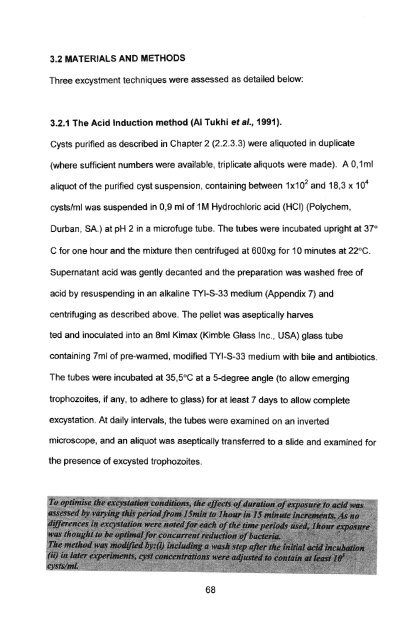in vitro culture and isoenzyme analysis of giardia lamblia
in vitro culture and isoenzyme analysis of giardia lamblia
in vitro culture and isoenzyme analysis of giardia lamblia
You also want an ePaper? Increase the reach of your titles
YUMPU automatically turns print PDFs into web optimized ePapers that Google loves.
3.2 MATERIALS AND METHODS<br />
Three excystment techniques were assessed as detailed below:<br />
3.2.1 The Acid Induction method (AI Tukhi et al., 1991).<br />
Cysts purified as described <strong>in</strong> Chapter 2 (2.2.3.3) were aliquoted <strong>in</strong> duplicate<br />
(where sufficient numbers were available, triplicate aliquots were made). A 0,1 ml<br />
aliquot <strong>of</strong> the purified cyst suspension, conta<strong>in</strong><strong>in</strong>g between 1 x1 0 2 <strong>and</strong> 18,3 x 10 4<br />
cysts/m I was suspended <strong>in</strong> 0,9 ml <strong>of</strong> 1 M Hydrochloric acid (Hel) (Polychem,<br />
Durban, SA.) at pH 2 <strong>in</strong> a micr<strong>of</strong>uge tube. The tubes were <strong>in</strong>cubated upright at 37°<br />
C for one hour <strong>and</strong> the mixture then centrifuged at 600xg for 10 m<strong>in</strong>utes at 22°C.<br />
Supernatant acid was gently decanted <strong>and</strong> the preparation was washed free <strong>of</strong><br />
acid by resuspend<strong>in</strong>g <strong>in</strong> an alkal<strong>in</strong>e TYI-S-33 medium (Appendix 7) <strong>and</strong><br />
centrifug<strong>in</strong>g as described above. The pellet was aseptically harves<br />
ted <strong>and</strong> <strong>in</strong>oculated <strong>in</strong>to an 8ml Kimax (Kimble Glass Inc., USA) glass tube<br />
conta<strong>in</strong><strong>in</strong>g 7ml <strong>of</strong> pre-warmed, modified TYI-S-33 medium with bile <strong>and</strong> antibiotics.<br />
The tubes were <strong>in</strong>cubated at 35,5°C at a 5-degree angle (to allow emerg<strong>in</strong>g<br />
trophozoites, if any, to adhere to glass) for at least 7 days to allow complete<br />
excystation. At daily <strong>in</strong>tervals, the tubes were exam<strong>in</strong>ed on an <strong>in</strong>verted<br />
microscope, <strong>and</strong> an aliquot was aseptically transferred to a slide <strong>and</strong> exam<strong>in</strong>ed for<br />
the presence <strong>of</strong> excysted trophozoites.<br />
68
















